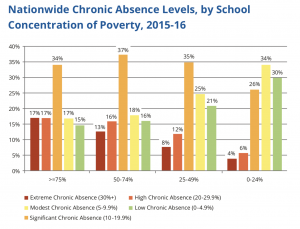 By Hedy N. Chang, Lauren Bauer, and Vaughan Byrnes
By Hedy N. Chang, Lauren Bauer, and Vaughan Byrnes
Publicly available and easy to scrutinize data is an invaluable tool for allowing everyone – from families to policy makers – to know whether chronic absence is a problem for their schools or communities so they can take appropriate action.
It also serves another purpose. While allowing for more collaboration, insight, and a shared learning environment, making chronic absence data accessible to the public helps improve the quality of the data.
When gathering data for our recently released report, Data Matters: Using Chronic Absence to Accelerate Action for Student Success, and the accompanying interactive data map, we did not audit the data on school-level chronic absence submitted to the Office for Civil Rights (OCR). In part, this was a deliberate choice to allow those using the materials to question whether the information provided to the Department of Education was correct.
After these materials were released a journalist noticed that the reported levels of chronic absence for Prince George’s County, Maryland were extremely high, at around 80 percent of all students. After looking into this inconsistency, we discovered that the district had made a mistake during the process of providing the data to the OCR Civil Rights Data Collection. The district had made an honest mistake and it was not an attempt to manipulate the statistics. In fact, the district-wide rate of chronic absence for Prince George’s County was approximately 29 percent. Unfortunately, the error was caught after the window for amending a data submission with OCR was closed.
After incorporating the accurate data on chronic absence from Prince George’s County into our analysis, we found that the inaccuracy had national significance. Because of the large size of Prince George County’s student population, the error changed national and African-American youth figures slightly. In addition, the revised data improved Maryland’s overall ranking, resulting in it having the 10th highest level of chronic absence, rather than the highest of all 50 states.
There are many types of errors that can happen in the course of collecting and reporting data. In the case of chronic absence, families, communities and others can examine transparently released data to question whether a school reporting no chronically absent students really has none, or whether there are poor data collection practices symptomatic of deeper problems. Similarly, stakeholder could question whether rates of chronic absence are too high.
We believe state education agencies can prevent data errors as much as possible by offering guidance around data definitions, data collection, and reporting, and including tips for reviewing data for accuracy prior to submission. When mistakes occur, it is important to provide opportunities for schools and districts to submit corrections.
For a more comprehensive look at steps that can be taken to strengthen attendance collection and to ensure districts are using the data to identify schools and students who need the most help, read a report we co-authored with FutureEd, Writing the Rules: Ensuring Chronic Absenteeism Data Works for Schools and Students.
Please take a moment to review our new versions of the Data Matters report and interactive data map that incorporate revised statistics from Prince George’s County from the school to the national level. Student chronic absence, and the consequence of lost instructional time, is a significant challenge in every state across the country. Use the updated tools and resources in the report to learn more about the scope and scale of the problem nationally and locally, its consequences and what can be done.
In the coming months, we anticipate that new chronic absence data will become publicly available. Chronic absence data by school and district is already being included in report cards by states who have adopted chronic absence as a measure of accountability. Eventually, the requirement of the Every Student Succeeds Act to include chronic absence in school report cards should ensure it is reported by all states.
We encourage all stakeholders to examine all data for accuracy and determine if missing too much school is a major challenge for their school. Having an accurate sense of which and how many students are chronically absent is essential to target action and resources and can help communities to measure progress over time.
What is the chronic absence rate in your local school or district? We are eager to continue the conversation around chronic absence data as we all work to ensure all students are on a pathway to attendance – and academic – success.
Chang, Bauer and Byrnes are authors of the report, Data Matters: Using Chronic Absence to Accelerate Action for Student Success.